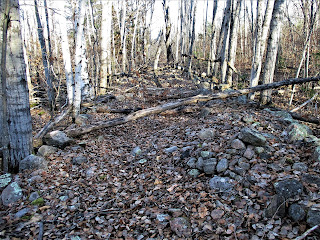During
the recent week of unseasonably warm weather, the willows around the
pond started to sport pussy willows on their branches, young beeches
dropped a lot of leaves that they usually hold onto until spring, and
the bush appears more open now. You can see way off through the trees
and the 'bones' of the country have become more visible. Pussy Willows
This area we live in, up in the hills along the far western edge of the Ottawa Valley, is hilly, rough and rocky. The productive bottom lands were settled first, after the loggers had been through, felling the large red and white pine forests. Up here, it wasn't until the 1870's that settlers invaded to clear and try to make a living from the land.
Our 'farm' was one of those places, and older folk around here say this was a working family farm until the mid 1950's. The family had horses, cows, pigs, and chickens, and scratched a meager existence from the soil. A friend in his 70's remembers when one could look across the cleared fields to the next concession. There were other farm buildings here, some burned down, some were dismantled and moved, one of which was the 'grainery' and is now a neighbour's beautiful little cabin. Ours is not the only farm here, each 100 or 200 acre section around sports the remnants of farming, some log buildings still quite intact.
All the back roads are bordered by stone fences, some easily seen, a lot that are more obscure. Each acreage is encircled by stone fences, and within the perimeters are many more stone fences, outlining what were once fields. This spring, Hubby took his GPS, turned on the tracker, and walked all the fence lines on our property, that he could discern, to make a map of the fences and try and figure out what was where. Some of the fences that were built across the wetter areas of the property have sunk down until they are just moss covered ridges of rock piles.
Other stone fences on the higher, dryer side, are still fairly high and distinct.
These rock fences fascinate me. They are beautiful, but oh, the aching hours of back-breaking work they entail! There are literally tons of rocks that have been moved off of the land and piled together.
The fences are built making two sides, a little distance apart, dry stone upon dry stone, interlocked for stable edges, and then other rocks and stones were thrown into the middle. Some rocks are very large and would have had to have been moved using horsepower. Some fences are wide and stable enough to drive on.
The exposed rocks are grey and weathered, lichen and moss covered, but upon moving a surface rock, one exposes dusty, soil covered rocks, looking as if they'd just been picked out of the sandy soil.
In places where bedrock protrudes up through the meager soil, rocks were piled on it, in the process of trying to clear the land for crops and grazing, so there are also random piles of rocks here and there.
There is one of them in our back yard, a 'design element'!Some large trees are encircled by rocks, obviously left as shady sentinels in a once cleared pasture.










I enjoyed reading that. I grew up in southwestern Ontario in a very productive agricultural area. There was a rock pile on my uncle's farmland, just a pile. Now that I live a little more north, we'll say Midwestern Ontario, I see what you see. Old rock fences creating the perimeters of fields. There are also old split rail fences. -Jenn
ReplyDeleteThank you, Jenn. Love those split rail, zig-zag fences! There were more of them where I grew up in Muskoka. The folks here used what was available, rocks. In places there are cedar posts protruding vertically from the stone fences and some cedar rails laying along the tops of the fences, all green and mossy, long since fallen down.
DeleteThis is so interesting. I can't even begin to imagine the work it to to make all of those stone fences! Thanks for sharing :)
ReplyDeleteMartha, the folks who settled here had no other option but to grow food, and supplement it with wild meat to survive. They cleared the land of trees and rocks and grew a lot of root crops I'm sure. It was an hard existence, supplemented by working in the bush for logging companies in the winters.
Delete